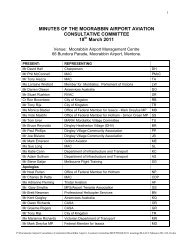Circuit Training at Moorabbin Airport Circuit Training at Moorabbin ...
Circuit Training at Moorabbin Airport Circuit Training at Moorabbin ...
Circuit Training at Moorabbin Airport Circuit Training at Moorabbin ...
Create successful ePaper yourself
Turn your PDF publications into a flip-book with our unique Google optimized e-Paper software.
6. MOORABBIN AIRPORT TRAINING AREA<br />
Much airwork training takes place to the South East of <strong>Moorabbin</strong> <strong>Airport</strong>. The requirements<br />
of the Airservices Australia Fly Neighbourly Advice (FN5) contained in ERSA GEN‐SP apply as<br />
follows:<br />
a) Design<strong>at</strong>ed areas AM/D314 and AM/D 315 are commonly referred to as the<br />
“<strong>Moorabbin</strong> <strong>Training</strong> Area” This is approxim<strong>at</strong>ely bounded by a line from <strong>Moorabbin</strong><br />
<strong>Airport</strong> to Pearcedale, then coastal to Koo‐wee‐rup, then Pakenham to <strong>Moorabbin</strong><br />
<strong>Airport</strong>.<br />
b) Pilots are requested to avoid the following urban areas: Hampton Park, Lyndhurst,<br />
Cranbourne and within circles of 1Nautical Mile of Cardinia and Fiveways joined<br />
tangentially. If not possible to avoid these areas pilots should traverse <strong>at</strong> an altitude<br />
not below 2,000ft.<br />
c) An aerob<strong>at</strong>ic area is established east of the Berwick‐Cranbourne Rd and north of<br />
Ballarto Rd. In this area pilots are requested to minimize aerob<strong>at</strong>ic maneuvers below<br />
3,000ft.<br />
d) Farm and other buildings should not be used as reference points for training<br />
maneuvers.<br />
7. GROUND RUNNING OF ENGINES<br />
Ground running of engines can cause noise concerns from well beyond the boundary of the<br />
airport.<br />
a) A purpose built engine test cell allows extended running of aircraft engines for<br />
maintenance and test purposes; with noise being channeled across non‐residential<br />
areas. All vehicle‐mounted engines on test will use this cell.<br />
b) Ground running of aircraft engines on airframes will be limited to run‐ups on the<br />
Northern or Southern run up bay between the hours of 0800‐1800 daily. Jet aircraft<br />
may additionally use the southern end of taxiway Echo which is furthest from<br />
residential housing.<br />
c) Run‐up of aircraft engines prior to flight will be accomplished in accordance with the<br />
oper<strong>at</strong>ional procedures prescribed for the aircraft type. Extended run‐ups will not be<br />
undertaken except if required to ensure the safety of flight.<br />
d) Please be mindful of the fact th<strong>at</strong> when there is low cloud the sound from engine<br />
run‐ups may carry some considerable distance from the airport.<br />
8. HELICOPTER OPERATIONS<br />
This Fly Friendly program applies to both fixed and rotary wing aircraft. Helicopters can<br />
potentially cause considerable noise irrit<strong>at</strong>ion and thus must conform to the same standard<br />
of behaviour as fixed wing oper<strong>at</strong>ions. However, for safety separ<strong>at</strong>ion reasons, helicopters<br />
will oper<strong>at</strong>e <strong>at</strong> different altitudes to fixed wing aircraft.<br />
91




